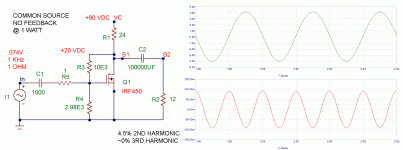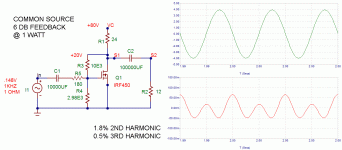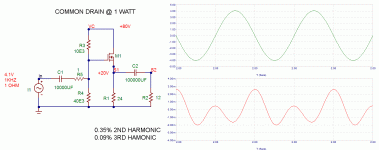I take no offense at all. I enjoy the excuse to step up on my favorite
soap boxes.

You must be way thinner than me. I fall right through!
Andrew and David,
Feedback is using a sample of the (an) output, sending it back to the (an) input to make the output a desired value.
A servo has to be negative feedback, otherwise the offset would be increased by the servo.
Whether you use opamps, chopper-stabilized, tubes or a fast operator with a potmeter, is immaterial. A servo is feedback and negative.
Does NOT need to be global. I have designed servo loops that are strictly local to the output stage. Works like a charm.
Edit: David I think I read your post wrong. I thought you meant a chopper-stabilized amp as a servo; you probably mean the process of chopper-stabilizing an amp. But, you bet it is (negative) feedback. With all the same stability issues a continuous servo has. Although, come to think of it, you probably can also use feedforward.
jan didden
Hi Jan,
Yes the edit is correct.
There seems to be an ongoing debate on this forum that pops up from time to time whether degeneration is negative feedback or not.
I don't really see how the two compare since they operate differently. Degeneration is a process of making, for a BJT, the effect of the intrinsic non-linear Re less significant by placing a linear resistance in series with it. If this is done with a 10:1 ratio of resistor to Re then isn't the effect of Re on the gain of an amplifier reduced to near one tenth?
This is very different than what negative feed back does so where does negative feedback come into degeneration?
Additionally, negative feed back has no effect on IPS gm or reduction of BJT beta sensitivity.
There is a large distinction between the two linearizing techniques.
David.
Hi Jan,
Yes the edit is correct.
There seems to be an ongoing debate on this forum that pops up from time to time whether degeneration is negative feedback or not.
I don't really see how the two compare since they operate differently. Degeneration is a process of making, for a BJT, the effect of the intrinsic non-linear Re less significant by placing a linear resistance in series with it. If this is done with a 10:1 ratio of resistor to Re then isn't the effect of Re on the gain of an amplifier reduced to near one tenth?
This is very different than what negative feed back does so where does negative feedback come into degeneration?
Additionally, negative feed back has no effect on IPS gm or reduction of BJT beta sensitivity.
There is a large distinction between the two linearizing techniques.
David.
If you have followed the last few pages, you can see that some members regard emitter degeneration as local negative feedback, some do not.
You CAN make a case for it. The emitter resistor makes the output voltage 'work against' the input voltage: if you have 1V input, the emitter will be at 0.999 volt so the effective input voltage is reduced to 0.001V. Exactly the same mechanism as any other negative feedback configuration. That's why the max gain can never be more than one, btw. That is how negative feedback works: use (part of) the output voltage to 'work against' the input voltage. Same diference
jan didden
Last edited:
If you have followed the last few pages, you can see that some members regard emitter degeneration as local negative feedback, some do not.
You CAN make a case for it. The emitter resistor makes the output voltage 'work against' the input voltage: if you have 1V input, the emitter will be at 0.999 volt so the effective input voltage is reduced to 0.001V. Exactly the same mechanism as any other negative feedback configuration. That's why the max gain can never be more than one, btw. That is how negative feedback works: use (part of) the output voltage to 'work against' the input voltage. Same diference
jan didden
Hi Jan
Are you trying to say that local feedback like emitter degeneration should be looked at in the same manner as global feedback?
Hi Jan
Are you trying to say that local feedback like emitter degeneration should be looked at in the same manner as global feedback?
I think Bob has demonstrated that effects on harmonics contents are not very different between local and global negative feedback.
Hi Jan
Are you trying to say that local feedback like emitter degeneration should be looked at in the same manner as global feedback?
Let me say this. If you look at the effects of global feedback and local (emitter degeneration) feedback, they look a lot alike:
- lower Zout (debatable for emitter degeneration)
- flatter freq response
- less distortion
- lower gain
- more stable operating point
- maybe more that I forget.
jan didden
Let me say this. If you look at the effects of global feedback and local (emitter degeneration) feedback, they look a lot alike:
- lower Zout (debatable for emitter degeneration)
- flatter freq response
- less distortion
- lower gain
- more stable operating point
- maybe more that I forget.
jan didden
Increase Zinput.
Increase Zinput.
Only with shunt feedback I think, with series fb Zin decreases, no?
jan didden
- lower Zout (debatable for emitter degeneration)
I think that's the one to drop. What example do we have of degeneration
that has the other characteristics and also lowers Zout?
OK, here's some entertainment:
Three circuits using the same gain device and running the same load
line, which is 1 watt into 8 ohms single-ended Class A.
The 1st is Common Source with no feedback
The 2nd is the same with 6db of feedback
The 3rd is Common Drain (follower)
The lower curve on each shows the distortion waveform.

Three circuits using the same gain device and running the same load
line, which is 1 watt into 8 ohms single-ended Class A.
The 1st is Common Source with no feedback
The 2nd is the same with 6db of feedback
The 3rd is Common Drain (follower)
The lower curve on each shows the distortion waveform.
Attachments
Nelson, yes, not only entertaining but also very expressive (sp?).
It illustrates several issues, for instance that the effect of an EF (SF) looks a lot like 100% feedback.
It also illustrates the so called 'Baxandall curves'; showing that increasing the feedback around a single non-linear device may lower the total THD but may increase the higher harmonics, until you get to high enough feedback that the higher ones start to decrease as well. Very nice illustrations!
I like to approach this more from a conceptual view. If you look at the attached figure, the topological similarities are quite clear. The EF has the drawback that one of the input- and the output terminal are intrinsically connected and cannot easily be separated so it's difficult to determine an EF 'with and without fb' situation.
In my opinion, showing the conceptual similarities help you to clarify both circuits with the same explanation. Considering them as conceptually different, despite the similarities, would require two different explanations and that doesn't seem like a good career move.
jan didden
It illustrates several issues, for instance that the effect of an EF (SF) looks a lot like 100% feedback.
It also illustrates the so called 'Baxandall curves'; showing that increasing the feedback around a single non-linear device may lower the total THD but may increase the higher harmonics, until you get to high enough feedback that the higher ones start to decrease as well. Very nice illustrations!
I like to approach this more from a conceptual view. If you look at the attached figure, the topological similarities are quite clear. The EF has the drawback that one of the input- and the output terminal are intrinsically connected and cannot easily be separated so it's difficult to determine an EF 'with and without fb' situation.
In my opinion, showing the conceptual similarities help you to clarify both circuits with the same explanation. Considering them as conceptually different, despite the similarities, would require two different explanations and that doesn't seem like a good career move.
jan didden
Attachments
Last edited:
One of the things I find interesting is that the ratio of 2nd and 3rd harmonic
is about the same in the latter two cases, even though the distortion figure
is quite different.

On to this "touchy" subject , in light of the fact that all the pass amps seem to have NFB and minimal components , does the ratio of H2 and 3 really matter ? The "entertainment amp" above in all 3 flavors has massive distortion , all the DIYA pass amps have massive distortion (as compared to Bob's
Not to infect Bob's fine thread with subjectivity , but as it relates to H2/3 ratio ,what will be the best sounding ? An amp with H2/3 down 100db+ , or one that has far more THD at the right "ratio" ? Is this "snake oil" or fact ?
PS - some in the solid state forum seem to be going in the direction of the "burning amp" for some reason.
http://www.diyaudio.com/forums/solid-state/186650-jfet-input-mosfet-vas-lateral-output-perfect-11.html
OS
Andrew and David,
Feedback is using a sample of the (an) output, sending it back to the (an) input to make the output a desired value.
A servo has to be negative feedback, otherwise the offset would be increased by the servo.
Whether you use opamps, chopper-stabilized, tubes or a fast operator with a potmeter, is immaterial. A servo is feedback and negative.
Does NOT need to be global. I have designed servo loops that are strictly local to the output stage. Works like a charm.
Edit: David I think I read your post wrong. I thought you meant a chopper-stabilized amp as a servo; you probably mean the process of chopper-stabilizing an amp. But, you bet it is (negative) feedback. With all the same stability issues a continuous servo has. Although, come to think of it, you probably can also use feedforward.
jan didden
Hi Jan,
This is a good explanation.
With DC servos, designers must be mindful that they can affect LF response and actually in some cases become unstable. Low-frequency peaking can certainly happen.
One also needs to be aware of the possibility of DC servo clipping. The input to the DC servo is the output of the amplifier (typically) and the gain of the DC servo integrator is less small at very low frequencies. This means that if the amplifier is putting out a very large signal at low frequencies, there is the potential for the DC servo circuit to clip if it is not properly designed.
Finally, since the DC servo injects a signal into the input end of the amplifier (typically), the DC servo IS in the signal path, and must be designed with a reasonable degreee of sonic-affecting detail.
Cheers,
Bob
[snip]Finally, since the DC servo injects a signal into the input end of the amplifier (typically), the DC servo IS in the signal path, and must be designed with a reasonable degreee of sonic-affecting detail.
Cheers,
Bob
Agree Bob. The servo amp is hit with signals in the full audio freq range. It needs to be able to handle high level, high freq error signals well. I've seen servos that did a great job servoing out the offset but injected all manner of higher-freq artifacts back into the input. Your servo opamp needs to be just as audiophile as anything else in the signal path.
jan didden
On to this "touchy" subject , in light of the fact that all the pass amps seem to have NFB and minimal components , does the ratio of H2 and 3 really matter ? The "entertainment amp" above in all 3 flavors has massive distortion , all the DIYA pass amps have massive distortion (as compared to Bob's). Why would anybody build in this manner when PPM THD is within reach (more NFB or GNFB ,and more devices)?
At what figure do you no longer perceive distortion? 1%? .1%? .01%?
.001%? .0001%? .00001%? I'm going to suggest that if people simply
want low distortion numbers for listening purposes, then we have achieved
that sometime ago, and everyone can go home.
Not to infect Bob's fine thread with subjectivity , but as it relates to H2/3 ratio ,what will be the best sounding ? An amp with H2/3 down 100db+ , or one that has far more THD at the right "ratio"?
Personally, I think it varies quite a bit between listeners, but probably the
most general observation came from Hiraga, who preferred a modest dose
of 2nd harmonic accompanied by a lesser dose of 3rd, and no significant
higher orders. If they are down 100 dB, I don't think it matters much.
There are some hints from work in cognitive psychology as to why this
might have a physical basis. If you are interested in this, I would
recommend "The Psychology of Music" edited by Diana Deutsch, chapters
9 through 11.
By N. pass - I'm going to suggest that if people simply
want low distortion numbers for listening purposes, then we have achieved
that sometime ago, and everyone can go home.
That means you also "straddle the fence" (consider both the engineering and psychological aspects) of amplifier design. How refreshing !
I have the PDF, "The Psychology of Music" , a PPM blameless , and know that the blameless is not always the most enjoyable of topologies. It really does do .001% or below (AP test) , but still falls short of "bliss". Instead of "going home" , I have endured criticism about being able to hear topology differences but know that it has an objective basis.
And sources.Personally, I think it varies quite a bit between listeners
I only used a PPM amp as a extreme example. Among the typical .01 - .05% vintage home or pro amp , the ones with (X) H2 and -3 to -6db as much H3 with minimal higher orders are "easier" on the ears. Absence of this requires adjusting the source ,I tend to... (without personal discrimination) cut my 2 - 5K EQ more on a known "distortionless"
Some would discount all of this , saying that loudspeakers have .5% THD (masking any amplifier)..then why all the different designs ?
OS
OS
From Nelson's third figure it appears that the load makes up part of the degeneration.
In a EF or SF push pull configuration any amount of applied bias loads the respective halves.
Is there ever an instance where some amount of feedback in not directly applied to the output of an EF or SF?
David.
In a EF or SF push pull configuration any amount of applied bias loads the respective halves.
Is there ever an instance where some amount of feedback in not directly applied to the output of an EF or SF?
David.
At what figure do you no longer perceive distortion? 1%? .1%? .01%?
.001%? .0001%? .00001%? I'm going to suggest that if people simply
want low distortion numbers for listening purposes, then we have achieved
that sometime ago, and everyone can go home.
Personally, I think it varies quite a bit between listeners...
While the psychology of perceiving musical sounds seems a great distance from the EE of amp design, the middle space between them also deserves some consideration. Specifically, the hearing organ (of Corti)... It seems that engineers assume it is a microphone with flat frequency response, and that it is identical among individuals. The circuitry of the inner and outer hair cells (the sound receptors) suggests the organ can be a filter in addition to a transducer. Of course, the transduction differences among individuals are significant...
Frank
BTW, many of Dr. Deutsch's publications are freely available online.
http://deutsch.ucsd.edu/psychology/deutsch_publications.php
Last edited:
- Home
- Amplifiers
- Solid State
- Bob Cordell's Power amplifier book


